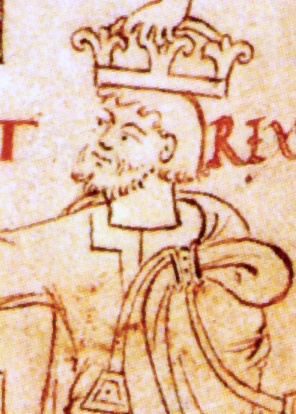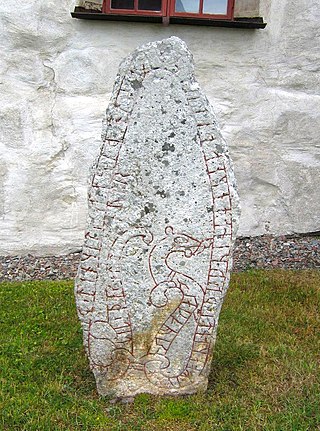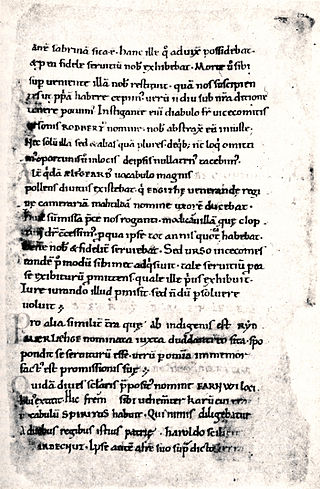
Æthelred II, known as Æthelred the Unready, was King of the English from 978 to 1013 and again from 1014 until his death in 1016. His epithet comes from the Old English word unræd meaning "poorly advised"; it is a pun on his name, which means "well advised".

Sweyn Forkbeard was King of Denmark from 986 until his death, King of England for five weeks from December 1013 until his death, and King of Norway from 999/1000 until 1013/14. He was the father of King Harald II of Denmark, King Cnut the Great, and Queen Estrid Svendsdatter.

Cnut, also known as Canute and with the epithet the Great, was King of England from 1016, King of Denmark from 1018, and King of Norway from 1028 until his death in 1035. The three kingdoms united under Cnut's rule are referred to together as the North Sea Empire by historians.

The Danelaw was the part of England between the early tenth century and the Norman Conquest under Anglo-Saxon rule in whch Danish laws applied. The Danelaw originated in the conquest and occupation of large parts of eastern and northern England by Danish Vikings in the late ninth century. The term applies to the areas in which English kings allowed the Danes to keep their own laws following the tenth-century English conquest in return for the Danish settlers' loyalty to the English crown. "Danelaw" is first recorded in the early 11th century as Dena lage.
Ælfgifu of Northampton was the first wife of Cnut the Great, King of England and Denmark, and mother of Harold Harefoot, King of England. She was regent of Norway from 1030 to 1035.

Æthelwold or Æthelwald was the younger of two known sons of Æthelred I, King of Wessex from 865 to 871. Æthelwold and his brother Æthelhelm were still infants when their father the king died while fighting a Danish Viking invasion. The throne passed to the king's younger brother Alfred the Great, who carried on the war against the Vikings and won a crucial victory at the Battle of Edington in 878.

Thorkell the Tall, also known as Thorkell the High in the Anglo-Saxon Chronicle, was a prominent member of the Jomsviking order and a notable lord. He was a son of the Scanian chieftain Strut-Harald, and a brother of Jarl Sigvaldi, Hemingr and Tófa. Thorkell was the chief commander of the Jomsvikings and the legendary stronghold Jomsborg, on the Island of Wollin. He is also credited as having received the young Cnut the Great into his care and taken Cnut on raids. The Encomium Emmae, a document aimed at the movers and shakers of the Anglo-Scandinavian court in the early 1040s, describes Thorkell as a great war leader and warrior.

Eadric Streona was Ealdorman of Mercia from 1007 until he was killed by King Cnut. Eadric was given the epithet "Streona" in Hemming's Cartulary because he appropriated church land and funds for himself. Eadric became infamous in the Middle Ages because of his traitorous actions during the Danish re-conquest of England.

The Battle of Assandun was fought between Danish and English armies on 18 October 1016. There is disagreement whether Assandun may be Ashdon near Saffron Walden in north Essex, England, or, as long supposed, Ashingdon near Rochford in south-east Essex. It ended in victory for the Danes, led by King Cnut, who triumphed over an English army led by King Edmund Ironside. The battle was the conclusion to Cnut's invasion of England.

The Thingmen was a unit in the service of the Kings of England during the period 1013–1051, financed by direct taxation which had its origins in the tribute known as Danegeld. It consisted mostly of men of Scandinavian descent and it had an initial strength of 3,000 housecarls and a fleet of 40 ships, which was subsequently reduced. Its last remnant was disbanded by Edward the Confessor in 1051.
Events from the 1010s in England.
Events from the 10th century in the Kingdom of England.
The Battle of Ringmere was fought on 5 May 1010. Between an East Anglian contingent led by Ulfcytel Snillingr and a danish army under Thorkell the Tall Norse sagas recorded a battle at Hringmaraheiðr; Old English Hringmere-hǣð, modern name Ringmere Heath. In his Víkingarvísur, the poet Sigvat records the victory of Saint Olaf, fighting alongside King Ethelred
Ælfgifu of York was the first wife of Æthelred the Unready, King of the English; as such, she was Queen of the English from their marriage in the 980s until her death in 1002. They had many children together, including Edmund Ironside. It is most probable that Ælfgifu was a daughter of Thored, Earl of southern Northumbria and his wife, Hilda.
Thored was a 10th-century Ealdorman of York, ruler of the southern half of the old Kingdom of Northumbria on behalf of the king of England. He was the son of either Gunnar or Oslac, northern ealdormen. If he was the former, he may have attained adulthood by the 960s, when a man of his name raided Westmorland. Other potential appearances in the records are likewise uncertain until 979, the point from which Thored's period as ealdorman can be accurately dated.
Ælfhelm was the ealdorman of Northumbria, in practice southern Northumbria, from about 994 until his death. An ealdorman was a senior nobleman who governed a province—a shire or group of shires—on behalf of the king. Ælfhelm's powerful and wealthy family came from Mercia, a territory and former kingdom incorporating most of central England, and he achieved his position despite being an outsider. Ælfhelm first appears in charters as dux ("ealdorman") in about 994.

The North Sea Empire, also known as the Anglo-Scandinavian Empire, was the personal union of the kingdoms of England, Denmark and Norway for most of the period between 1013 and 1042 towards the end of the Viking Age. This ephemeral Norse-ruled empire was a thalassocracy, its components only connected by and dependent upon the sea.

Viking activity in the British Isles occurred during the Early Middle Ages, the 8th to the 11th centuries CE, when Scandinavians travelled to the British Isles to raid, conquer, settle and trade. They are generally referred to as Vikings, but some scholars debate whether the term Viking represented all Scandinavian settlers or just those who used violence.

In the autumn of 1016, the Danish prince Cnut the Great (Canute) together with the Norwegian fleet of Eiríkr Hákonarson successfully invaded England. Cnut's father, Sweyn Forkbeard, had previously conquered and briefly ruled England for less than five weeks.
The battle of Thetford occurred in 1004. The Anglo-Saxon chronicle reports Ulfcytel Snillingr raised an East Anglian fyrd to meet Sweyn Forkbeard in battle.









